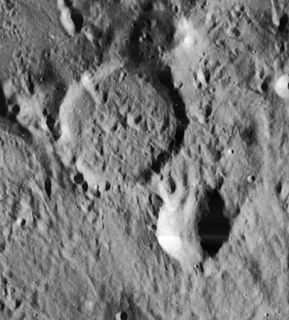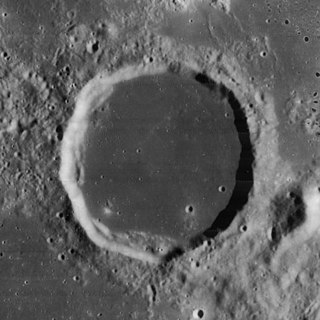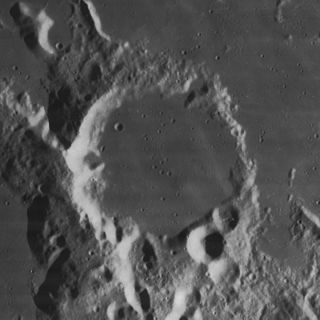
Fracastorius is the lava-flooded remnant of an ancient lunar impact crater located at the southern edge of Mare Nectaris. To the northwest of this formation lies the crater Beaumont, while to the northeast is Rosse.

Gay-Lussac is a lunar impact crater located to the north of the prominent crater Copernicus, in the southern foothills of the Montes Carpatus range. The rim of the crater is slightly distorted, although generally circular. The inner floor is flat but rough, with no central peak. There are a pair of small craterlet depressions in the middle instead of a central peak. The associated crater Gay-Lussac A is nearly joined to the southeast rim.

Cleomedes is a prominent lunar impact crater located in the northeast part of the visible Moon, to the north of Mare Crisium. It was named after Greek astronomer Cleomedes. It is surrounded by rough ground with multiple crater impacts. The irregular crater Tralles intrudes into the northwest rim. To the east is Delmotte. North of Cleomedes is a triple-crater formation with Burckhardt occupying the center.

Ariadaeus is a small, bowl-shaped lunar impact crater on the western shores of Mare Tranquillitatis. It lies to the north of the crater Dionysius, and to the west-southwest of Arago. The crater is joined along the northeast rim by the slightly smaller Ariadaeus A, and the two form a double-crater. Its diameter is 10.4 km.

Boscovich is a lunar impact crater that has been almost completely eroded away by subsequent impacts. It is located west-northwest of the crater Julius Caesar, and south-southeast of the prominent Manilius. The crater floor has a low albedo, and the dark hue makes it relatively easy to recognize. The surface is crossed by the rille system designated Rimae Boscovich that extends for a diameter of 40 kilometres. The crater is named after Croatian physicist Roger Joseph Boscovich.

Cardanus is a lunar impact crater that is located in the western part of the Moon, in the western part of the Oceanus Procellarum. Due to its location the crater appears very oval because of foreshortening, and it is viewed almost from the side.

Cavendish is a lunar impact crater that is located in the southwest part of the Moon, to the southwest of the larger crater Mersenius. It lies between the smaller craters Henry to the west-northwest and de Gasparis to the east-southeast.

Delisle is a small lunar impact crater in the western part of the Mare Imbrium. It was named after French astronomer Joseph-Nicolas Delisle. It lies to the north of the crater Diophantus, and just to the northwest of the ridge designated Mons Delisle. Between Delisle and Diophantus is a sinuous rille named Rima Diophantus, with a diameter of 150 km. To the northeast is another rille designated Rima Delisle, named after this crater.

Goclenius is a lunar impact crater that is located near the west edge of Mare Fecunditatis. It lies to the southeast of the lava-flooded crater Gutenberg, and north of Magelhaens. To the northwest is a parallel rille system that follow a course toward the northwest, running for a length of up to 240 kilometers. This feature is named the Rimae Goclenius.

Hippalus is the remnant of a lunar impact crater on the eastern edge of Mare Humorum. It was named after ancient Greek explorer Hippalus. To the southeast is the crater Campanus, and to the northwest is the small flooded crater Loewy.

Réaumur is the remains of a lunar impact crater located on the southern edge of Sinus Medii. Its diameter is 51 km. It was named after the 18th century French scientist René de Réaumur. It shares an eroded rim with the similar crater Oppolzer to the northwest. It lies to the northwest of the large walled plain Hipparchus, and east of Flammarion. To the south is Gyldén, and farther to the south-southwest is Ptolemaeus.

Billy is a lunar impact crater that is located at the southern fringes of the Oceanus Procellarum, in the western hemisphere of the Moon. It was named after French mathematician Jacques de Billy. It lies to the southeast of the similar-sized crater Hansteen, and west-southwest of the flooded Letronne.

Calippus is a small lunar impact crater that is located on the eastern edge of the rugged Montes Caucasus mountain range in the northern part of the Moon. It was named after Greek astronomer Callippus of Cyzicus. It lies to the southwest of the crater remnant Alexander, to the northwest of the Mare Serenitatis.

Karpinskiy is a lunar impact crater that lies in the northern part of the Moon on the far side from the Earth. This crater is concentric with a larger and older formation lying along the southern rim. This combined rim gives Karpinskiy a larger and wider interior wall along its south face. Just to the north is the double-crater formation of Milankovic and Ricco, which lies across the northern part of the large crater containing Karpinskiy. To the southeast of Karpinskiy is the smaller crater Schjellerup.

Bunsen is a lunar impact crater that lies near the northwestern limb of the Moon. It is located to the west of the Oceanus Procellarum and the crater von Braun. To the southeast is the crater Lavoisier, and to the northeast lies Gerard. Northwest of Bunsen, on the far side of the Moon, is McLaughlin. Due to its position this crater appears foreshortened when viewed from the Earth, and its visibility is affected by libration.

Campanus is a lunar impact crater that is located on the southwestern edge of Mare Nubium. It was named after Italian astronomer Campanus of Novara. It forms a crater pair with Mercator just to the southeast. Along the southern rampart of Campanus is the small lunar mare named Palus Epidemiarum. To the southwest is the small crater Dunthorne.

Capuanus is a lunar impact crater that lies along the southern edge of the Palus Epidemiarum. It was named after Italian astronomer F. Capuano di Manfredonia. The outer rim is eroded and indented by lesser crater impacts, with notches in the north, west, and southern parts of the rim. The interior floor has been resurfaced by basaltic lava, which is connected to the surrounding lunar mare by a narrow, crater-formed gap in the northern rim. Dotting the floor of the crater are a number of domes, which are believed to have formed through volcanic activity.

Damoiseau is a lunar impact crater that is located just to the west of the Oceanus Procellarum, in the western part of the Moon's near side. It lies due east of the prominent crater Grimaldi, a walled plain with a distinctive dark floor. Due south of Damoiseau is the crater Sirsalis.

Yangelʹ is a small lunar impact crater that is located in the irregular terrain to the north of the Mare Vaporum. Its diameter is 8 km. It was named after Soviet rocketry scientist Mikhail Kuzmich Yangelʹ in 1973. This crater was formerly designated Manilius F.
Fontana is a lunar impact crater that is located in the southwestern part of the Moon's near side, to the south of the Oceanus Procellarum. It lies to the west-northwest of the flooded crater Zupus. Midway between Fontana and Zupus is a rille system designated Rimae Zupus.























